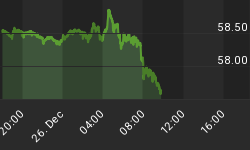Currencies
The daily chart of the Canadian dollar index is shown below, with the index in closer proximity to the upper 21 and 34 MA Bollinger bands...not that lower 21 and 34 MA Bollinger bands are in close proximity to the index. This suggests that a breakout to the upside or downside from the consolidation over the past month is probable. The lower 55 MA BB is starting to rise up, suggestive that a decline is probable over the course of the next month. Full stochastics 1, 2 and 3 are shown below in order of descent, with the %K beneath the %D in 2 and 3. It is difficult to accurately state what the Canadian dollar is going to do at present, given the tightness of BB's and the %K marginally above the %D in stochastic 1. I would not rule out the potential for a final move higher in the Canadian dollar, because if the %K in stochastic 1 rises, it will be a 2-3 week trend.
Figure 1
The daily chart of the Australian dollar index is shown below, with the index above the upper 21 and 34 MA Bollinger bands and nearing proximity to the 55 MA BB. Lower 21 and 34 MA Bollinger bands are in close proximity to each other...since upper and lower 21 and 34 MA BB's are in close proximity to each other, a breakout of the upside or downside from the recent consolidation pattern is probable (to the upside in this case). Full stochastics 1, 2 and 3 are shown below in order of descent, with the %K above the %D in 2 and 3. The rally in the XAD is overextended, but there is the potential for the present rally to continue for an additional 2-3 weeks.
Figure 2
The daily chart of the Euro index is shown below, with the closing price above all three upper Bollinger bands. This represents a potential red flag that a topping process is underway and could see a sharp spike conclude the rally over the next 1-3 weeks. Lower 21 and 34 MA BB's have curled down, coinciding with the recent breakout. When the lower 21 and 34 MA BB's begin to curl up a top will be in place. Full stochastics 1, 2 and 3 are shown below in order of descent, with the %K above the %D in 1 and 2...note the %K in stochastic 3 is trying to curl higher, suggestive the trend is likely up. The %K in stochastic 1 could trend higher for 1-3 weeks, which suggests commodities may top out near the end of September.
Figure 3
US Dollar Index
The daily chart of the US Dollar index is shown below, with all three lower Bollinger bands riding the index lower, suggestive that the downward trend is still intact. Full stochastics 1, 2 and 3 are shown below in order of descent, with the %K beneath the %D in 2 and 3...based on the present trend, it could continue for another 2-3 weeks.
Figure 4
The weekly chart of the Euro is shown below, with all three lower Bollinger band sin close proximity to each other, indicating the downward trend is still intact. Full stochastics 1, 2 and 3 are shown below in order of descent, with the %K beneath the %D in all three instances. Based upon extrapolation of the %K in stochastics 1 and 2, downside in the USD is likely to continue for at least 2-3 weeks, potentially longer. When a bottom has been put in place, expect a sharp rally to follow.
Figure 5
The monthly chart of the USD index is shown below, with all three lower Bollinger bands between 68 and 70. This suggests that the 2008 bottom will hold and that the USD at present is merely in a downward trend before heading higher. Upper 21 and 34 MA Bollinger bands are in close proximity to each other, indicating that downward pressure is still intact. Full stochastics 1, 2 and 3 are shown below in order of descent, with the %K beneath the %D in 1 and above it in 2 and 3. Based upon positioning of the %K in stochastics 2 and 3, it appears the USD is in a multi-year upward trend (maintaining levels above the 2008 lows).
Figure 6
The short-term Elliott Wave count of the USD index is shown below, with the older thought patterns forming shown in green. The USD took longer to break lower than previously thought, but it appears the final leg down in the dollar is presently underway.
Figure 7
The mid-term Elliott Wave count of the USD index is shown below, with the thought pattern forming denoted in green. The USD has hit the expected target zone, so everyone must show some patience to see what kind of basing pattern forms. If the USD remains above 76, then the basing pattern could be complete in 2-3 weeks...however, if 76 is taken out, it opens up the possibility for a test of the former lows before heading higher. Under the latter scenario, this would cause a temporary sharp spike in the price of gold.
Figure 8
In short, expect commodities, other currencies and the broad stock market indices to continue to exhibit sideways to upward grinding price increases over the course of the next 2-3 weeks. Once the USD puts a bottom in, all of the above are likely to decline due to their inverse relationship to the USD at present. Since Stockcharts was down last night, I will post the S&P 500 index later on tonight.
















